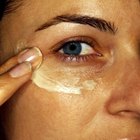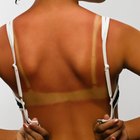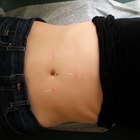
Jupiterimages/Pixland/Getty Images
Retin-A, a derivative of vitamin A, is a compound containing retinoic acid and tretinoin. Renova® is a prescription cream approved by the FDA for treating sun damage and natural aging. Unlike Retin-A, Renova® contains additional ingredients to create a smoother effect on skin.
Retin-A
Retin-A may come in the form of a gel or cream and is applied to the top layer of skin. It was first approved by the FDA for acne treatment. With use of Retin-A, patients began to notice improvements in their skin’s overall appearance. As a result, Retin-A is now used for many cosmetic purposes also.
Usage
A dermatologist may prescribe Retin-A for daily use. It should be applied after cleaning the skin with a mild cleanser. Patients may need to apply sunscreen because of increased photosensitivity while using Retin-A.
Side Effects
When using Retin-A, patients may notice increased redness, dryness and swollen or blistered skin. Side effects vary depending on skin type and Retin-A concentration.
Renova®
Renova® contains tretinoin, a vitamin A derivative. Renova® is believed to work in the layers of skin below the surface where pigment changes occur and even in the areas of skin where wrinkles begin to surface. Renova® may reduce the appearance of fine lines and wrinkles, certain dark and light spots, or roughness of facial skin.
Usage
A dermatologist may prescribe Renova® for daily use. It should be applied after cleaning the skin with a mild cleanser. Patients should apply a small amount of the product onto the face, carefully avoiding the eyes and mouth.
Side Effects
When using the product, patients may notice increased redness, dryness or flaking of skin. Patients using Renova® are encouraged to avoid the sunlight because of increased photosensitivity. Dermatologists may recommend a sunscreen regimen while using the product.
Related Articles

Removing Acne Scars With Tretinoin Cream

Possible Side Effects of Obagi

List of Retinoids

Does Retin-A Micro Gel Get Rid of ...

The Best Facial Moisturizers for People ...

Estrogen in Skin Creams

Can Tri-Luma Be Used to Fade Acne Scars?

Oil of Olay & Wrinkles

Skin Care Products That Contain ...

Tazorac Cream & What it Does for Acne

Estradiol Cream & Wrinkles

Side Effects of Cosmelan

Hydroquinone & Dark Circles

Benefits of Shea Butter and Coconut Oil ...

Aloe Vera Gel As a Wrinkle Reducer

Jojoba Oil Benefits

How to Get Rid of Skin Discoloration on ...

What Are the Dangers of Fraxel Repair?

What Creams Can I Use at Home After ...

How to Even Out Skin Tone Without Makeup
References
Writer Bio
This article was written by the CareerTrend team, copy edited and fact checked through a multi-point auditing system, in efforts to ensure our readers only receive the best information. To submit your questions or ideas, or to simply learn more about CareerTrend, contact us [here](http://careertrend.com/about-us).
Photo Credits
Jupiterimages/Pixland/Getty Images